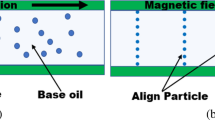Abstract
In this study, we develop a novel damper prototype for robot manipulators of a mobile robot to perform rescue operations in extreme environments like battlefields. Shock vibrations occur when such robots drive over rugged terrain, adversely affecting both the robot and the rescued person. We propose a joint module that utilizes magnetorheological (MR) fluid to depress environmental impact vibrations. To do this, we first suggest a novel structure for our MR damper, with multiple working coils to augment the magnetic field intensity for the given volume; then, we perform dynamic simulations on the manipulator with the suggested MR damper installed, examining vertical impact acceleration and the driving torque generated in the joint module. The proposed damper can best reduce the amplitude of vibrations by about 90\(\%\) at 21 Hz and by about 30\(\%\) at the system’s resonant frequency of 22 Hz, which are the frequencies of interest as those lie around the natural frequency of the robot arm.














Similar content being viewed by others
References
Jayaseelan P, Saminathan A, Sathish M (2014) Multi special robot systems for detection and rectification of rescue units. Int J Adv Res Comput Sci Softw Eng 4(2):1087–1092
Schwarz M et al (2017) Nimbro rescue: solving disaster-response tasks with the mobile manipulation robot momaro. J Field Robot 34(2):400–425
Xin L, Bin D (2013) The latest status and development trends of military unmanned ground vehicles, IEEE, pp 533–537
Hu J et al (2011) An advanced medical robotic system augmenting healthcare capabilities-robotic nursing assistant, IEEE, pp 6264–6269
Hong S, Lee WS, Kang YS, Park YW (2014) Kinematic control algorithms and robust controller design for rescue robot, IEEE, pp 637–642
Huber F et al (2013) First analysis and experiments in aerial manipulation using fully actuated redundant robot arm, IEEE, pp 3452–3457
Mahyuddin MN, Khan SG, Herrmann G (2014) A novel robust adaptive control algorithm with finite-time online parameter estimation of a humanoid robot arm. Robot Auton Syst 62(3):294–305
Rahimi H, Nazemizadeh M (2014) Dynamic analysis and intelligent control techniques for flexible manipulators: a review. Adv Robot 28(2):63–76
Douat LR et al (2013) Identification and vibration attenuation for the parallel robot par2. IEEE Trans Control Syst Technol 22(1):190–200
Xie X, Huang J, Liang Z (2013) Vibration reduction for flexible systems by command smoothing. Mech Syst Signal Process 39(1–2):461–470
Campeau-Lecours A, Otis M, Belzile P-L, Gosselin C (2016) A time-domain vibration observer and controller for physical human–robot interaction. Mechatronics 36:45–53
El-Gohary M, McNames J (2015) Human joint angle estimation with inertial sensors and validation with a robot arm. IEEE Trans Biomed Eng 62(7):1759–1767
D Fan C, Liao Y (2016) Robust optimal motion planning for vibration reduction of free-floating flexible manipulator system, IEEE, pp 489–494
Plooij M, Mathijssen G, Cherelle P, Lefeber D, Vanderborght B (2015) Lock your robot: a review of locking devices in robotics. IEEE Robot Autom Mag 22(1):106–117
Youn D, Park J, Choi S, Yun S, Ham S (2006) Electromagnetic analysis and design of rotary MR brake, pp 146–151
Schmitz A et al (2015) A concept for a robot arm with adjustable series clutch actuators and passive gravity compensation for enhanced safety, IEEE, pp 1322–1327
Wilson A (2017) Design and development of a magneto-rheological linear clutch for force controlled human safe robots, IEEE, pp 614–619
Lebel LP et al A cable-driven robotic arm powered by magnetorheological clutches for upper-limbs physical interaction in virtual reality environment
Okui M, Iikawa S, Yamada Y, Nakamura T (2018) Fundamental characteristic of novel actuation system with variable viscoelastic joints and magneto-rheological clutches for human assistance. J Intell Mater Syst Struct 29(1):82–90
Véronneau C et al (2019) A lightweight force-controllable wearable arm based on magnetorheological-hydrostatic actuators, IEEE, pp 4018–4024
Denis J, Plante J-S, Girard A (2021) Low-level force-control of MR-hydrostatic actuators. IEEE Robot Autom Lett 6(2):3849–3856
Cinq-Mars M, Gurocak H (2017) Pneumatic cylinder with magnetorheological brake using serpentine and helix flux guide as a linear hybrid actuator for haptics. J Intell Mater Syst Struct 28(10):1303–1321
Wang D, Yao L, Pang J, Cao Z (2017) Design, modeling and analysis of a magnetorheological fluids-based soft actuator for robotic joints, Springer, pp 753–764
Dong X, Liu W, Wang X, Yu J, Chen P (2017) Research on variable stiffness and damping magnetorheological actuator for robot joint, Springer, pp 109–119
Lima JJ et al (2019) On positioning and vibration control application to robotic manipulators with a nonideal load carrying. Shock Vib. https://doi.org/10.1155/2019/5408519
Zhang C et al (2018) Design and experiment evaluation of a magneto-rheological damper for the legged robot, IEEE, pp 687–692
Li Z, Wu Z, Cui, J (2014) Vibration suppression for Scara robot with magnetorhelogical damper by using switching control, IEEE, pp 730–735
Rosli R, Mohamed Z, Priyandoko G (2021) Simulation of active force control using MR damper in semi active seat suspension system, vol 1062, IOP Publishing, p 012005
Yun D, Koo J-H (2017) Design and analysis of an MR rotary brake for self-regulating braking torques. Rev Sci Instrum 88(5):055103
Author information
Authors and Affiliations
Corresponding author
Additional information
Publisher's Note
Springer Nature remains neutral with regard to jurisdictional claims in published maps and institutional affiliations.
Rights and permissions
Springer Nature or its licensor holds exclusive rights to this article under a publishing agreement with the author(s) or other rightsholder(s); author self-archiving of the accepted manuscript version of this article is solely governed by the terms of such publishing agreement and applicable law.
About this article
Cite this article
Yun, D., Park, C., Park, D. et al. Magnetorheological damper for vibration reduction in a robot arm. Intel Serv Robotics 15, 671–678 (2022). https://doi.org/10.1007/s11370-022-00445-3
Received:
Accepted:
Published:
Issue Date:
DOI: https://doi.org/10.1007/s11370-022-00445-3




